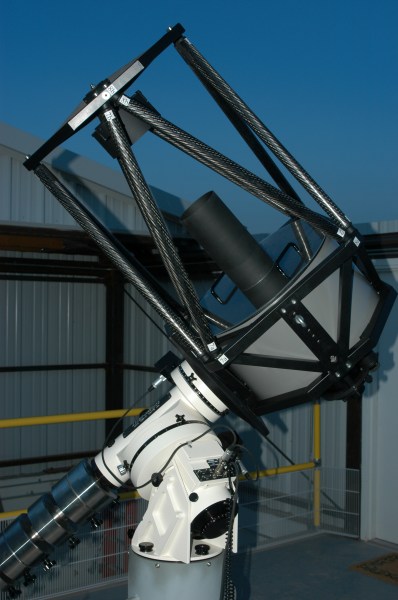
The main optical instrument at the Bunker Ranch Observatory is the 400mm Hypergraph; this is a corrected Ritchey-Chretien telescope by Astro-Optik of Germany. An R-C is one of a family of two-mirror optical system in which the secondary mirror reflects the light through a hole in the center of the primary mirror, forming an image behind the primary.
The Ritchey-Chretien design uses a hyperbolic primary and a hyperbolic secondary to produce images in which the stars are round across the entire field; this makes it very suitable for photography. The main aberration is that the star image circles are larger as one moves away from the center of the image; this is corrected by a lens system that is placed in the central hole of the primary mirror.
This particular instrument is f/8, which is somewhat slow photographically, but the longer focal length is an advantage in what will be its primary job of imaging galaxies.
The truss rods are made of carbon fiber, which has a near-zero coefficient of thermal expansion. This holds the spacing between the primary and secondary mirrors constant even through the wide temperature swings of the high desert, maintaining the telescope's focus. One benefit of this is that long time exposures do not need to be suspended for refocusing as the temperature plummets at night.
The optics were made by LOMO, the Russian company that built the 6 meter (236") Bolshoi Teleskop Azimutal'ny (BTA) in the Caucasus Mountains. The mirrors are made of Sital glass ceramic, which has a very low thermal expansion coefficient (this is a fancy way of saying that the mirror retains its figure through large temperature changes). Retaining figure with varying temperature helps when shaping the reflective surface (because grinding heats the mirror) and when observing (because otherwise, the shape of the reflective surface would distort during air temperature changes).
(Photograph by Robert Buehler)
Many instruments of this type are focused by moving the secondary mirror toward or away from the primary mirror; this allows for a very wide range of focal positions behind the primary. However, it does also induce some (very slight) aberration, because the primary and secondary mirror curves are optimized for a single fixed spacing. The Hypergraph instead focuses in the traditional way, with a moving focuser tube behind the primary. The total focus travel is 65mm for this particular telescope, which requires some attention to detail when designing imaging trains. Fortunately, the image plane is 373mm behind the back plate of the optical tube, so there's lots of room to hang equipment off the focuser.
Terry R. Friedrichsen
terry@mail.trf.sunquest.com